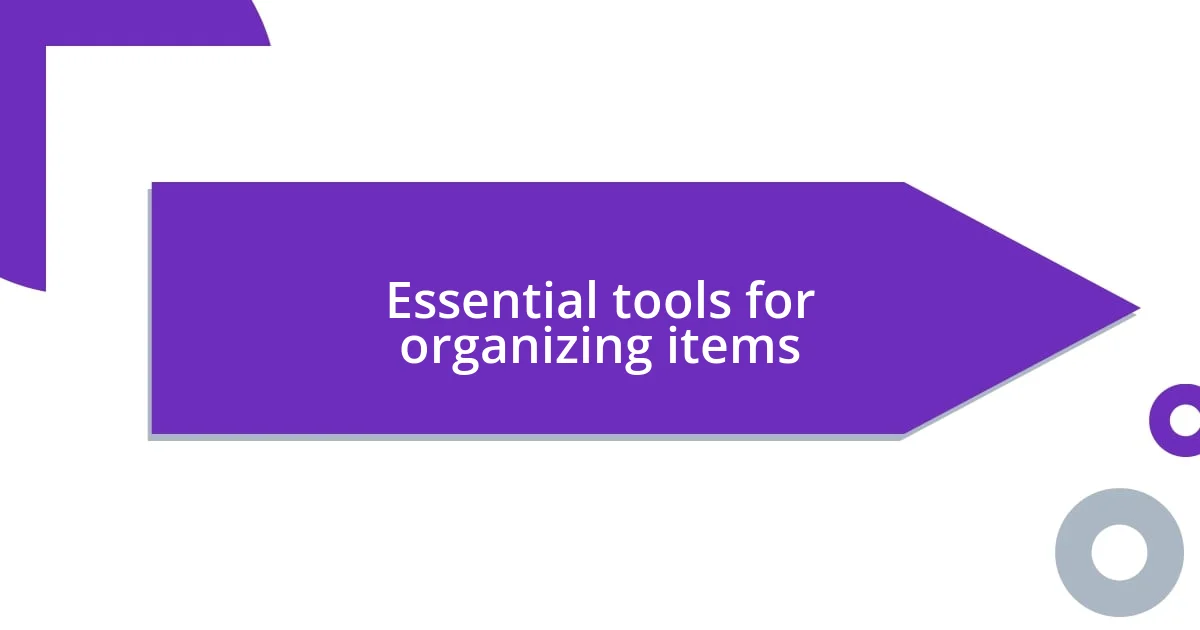Key takeaways:
- Effective seasonal item management combines strategic planning, detailed inventory tracking, and customer feedback to forecast demand and streamline organization.
- Utilizing essential tools like clear plastic bins, shelving units, and digital inventory systems enhances visibility and access, reducing chaos during seasonal transitions.
- Adapting strategies with seasonal changes and maintaining items through cleaning, regular checks, and careful labeling contribute to a smoother and more enjoyable decoration process each year.

Understanding seasonal item management
Managing seasonal items can often feel like juggling multiple tasks at once. I remember the first time I tackled my holiday decorations; I thought I could just throw everything in a box, but I quickly learned that organization is key. How many times have you rummaged through a disheveled pile of items, wishing you’d done things differently?
One of the biggest challenges I faced was predicting demand for certain seasonal items. In my experience, some things absolutely fly off the shelves, while others collect dust. This unpredictability can lead to overstocking or understocking, which can be frustrating. Have you ever been left with excess inventory that felt like a burden? I know I have, and it’s a tough pill to swallow, knowing that money is tied up in products that simply didn’t resonate.
Effective seasonal item management requires a blend of strategic planning and genuine intuition. I’ve found that keeping a detailed inventory, analyzing sales trends from previous years, and even tapping into customer feedback can provide invaluable insight. It’s fascinating how much information can shape our decisions about what items to keep or retire. Have you ever considered how your own experiences with seasonal items could guide your future choices? Reflecting on this has transformed my approach to seasonal inventory management, making it a more personal and effective process.

Essential tools for organizing items
When it comes to organizing seasonal items, having the right tools is a game changer. Personally, I swear by clear plastic bins for visibility. The moment I switched to those from cardboard boxes, it felt like a weight lifted. No more guessing what’s inside; I can see everything at a glance. Plus, labeling each bin with a specific season or occasion has saved me so much time during those chaotic decoration weekends. Anyone else dread the last-minute hunt for that one elusive ornament?
Another essential tool in my toolkit is shelving units. I remember feeling overwhelmed by clutter until I introduced sturdy shelves into my storage area. Elevating items off the floor not only maximizes space but also keeps everything accessible and organized. I try to categorize my items – ornaments on one shelf, holiday lights on another. It’s practically an instant mood booster when everything has its designated spot.
Lastly, I can’t emphasize the importance of a digital inventory system enough. It may sound overly technical, but I’ve found apps that track what I have, where it’s stored, and even when it’s time to rotate my stock. This has transformed how I keep tabs on my seasonal items. Picture this: I used to scramble through boxes every time a holiday approached, forgetting essentials until the last minute. Now, I simply pull up my app and plan ahead. It’s the little things that can bring so much peace of mind!
| Tool | Description |
|---|---|
| Clear Plastic Bins | Allows visibility and easy identification of items inside. |
| Shelving Units | Maximizes space and keeps items organized and accessible. |
| Digital Inventory System | Tracks items and helps plan ahead for seasonal needs. |

Inventory strategies for seasonal items
Effective inventory strategies for managing seasonal items can truly make a difference. One method that has worked wonders for me is implementing a seasonal calendar. I remember the first year I mapped out my seasonal needs month by month; it felt like I finally gained control over the chaos! This approach not only helps in forecasting demand but also allows you to plan promotions and sales around those peak times. Having everything laid out visually has turned what once felt like a guessing game into a clear roadmap.
Here are some additional strategies that can help streamline your inventory management:
- Regular Audits: Schedule regular checks on your inventory to assess what’s selling well and what isn’t. This proactive approach keeps surprises at bay.
- Customer Feedback: Keep your ears open for comments and suggestions from customers. Their perspectives often reveal which items are hot and which are not.
- Flexible Reordering Systems: Establish a system that allows for quick adjustments in your orders based on real-time sales data. I’ve found that flexibility can save not just inventory but also stress during peak seasons.
- Grouping by Category: I often group items by their usage periods. For instance, all holiday décor goes in one area and fall items in another. This eliminates the “what did I even pack?” moments that used to overwhelm me.
Adopting these strategies has helped me foster a much healthier relationship with seasonal inventory management, making it not just a task, but an engaging part of my yearly rhythm.

Labeling techniques for seasonal items
One of my favorite labeling techniques is color coding. I remember when I first experimented with this method—suddenly, my storage area became a rainbow of seasons! Each color represents a different occasion, like red for Christmas and orange for Halloween. It’s not only visually appealing, but it also makes grabbing the right bin a breeze. Have you ever spent ages sifting through gray boxes only to find the pumpkin decor in a blue bin? Color coding can eliminate that stress.
I also love using laminated labels for added durability. During one particularly chaotic holiday season, I faced the infamous attack of holiday lights entangled like a cat’s plaything. But with sturdy, water-resistant labels clearly indicating what’s inside each bin, I reduced the chances of unraveling those holiday light mysteries amid the madness. The labels withstand the chaos of temperatures and time, making them trusty companions in my organization journey.
Lastly, I’ve started incorporating both written and digital labels. Think of it as a little backup plan. I jot down key information on the label, like the year an item was purchased, and snap a photo to save digitally. This dual approach helps prevent the dreaded item mix-up—especially during those exciting, but hectic decoration days when I’m overwhelmed with joy and nostalgia. Have you ever felt elated yet chaotic while decorating? With these labeling techniques, I’ve mastered balancing both!

Seasonal item maintenance tips
Maintaining seasonal items requires more than just proper storage; it’s about nurturing those items to ensure they serve you well season after season. One tip that’s transformed my approach is cleaning items before and after each season. I vividly remember the first time I neglected this step; I pulled out lovely twinkling lights only to find they were coated in dust and tangled up like a mystery knot! Now, I make it a ritual to inspect and clean each item as I pack it away, often finding hidden flaws that I can address before the next season.
Another maintenance tip I swear by is checking for potential damage. Whenever I unpack my Halloween decorations, I do a quick inventory to spot any wear and tear. It’s surprising how much a small chip or frayed wire can affect the overall look of your setup! I’ve learned to set aside a bit of time for quick repairs, using my trusty glue gun for minor fixes. This not only extends the life of my favorite decorations but also adds a personal touch, knowing they’ve been cared for.
Lastly, I recommend creating a seasonal checklist to streamline your maintenance routine. I remember feeling overwhelmed during my first holiday preparation and wishing I had a guide to follow. Now, as I unpack and assess each item, I tick off parts of my checklist, from string lights to table settings. It feels rewarding to see progress, and I can’t tell you how much it alleviates the stress of last-minute scrambling! Having that systematic approach keeps me organized and reminds me of the joy each season brings, allowing me to focus on creating beautiful moments with family and friends.

Adapting your strategy each season
Adapting my strategy each season has become almost an instinct for me. I’ve learned that with every seasonal transition, my approach needs a little tweak. For instance, when summer rolls in, I swap out heavy decor for lighter, breezier pieces. I still remember the first summer I forgot this and ended up with a house that felt like a holiday leftover. That was a wake-up call to embrace seasonal vibes—will you adjust your decor to match the mood of the season?
I often reflect on how seasonal changes influence not just what I display, but how I feel in my space. Fall, for example, beckons for cozy blankets and warm colors, and I always delve into my stash of pumpkin-scented candles. It’s like bringing the essence of the season indoors. I notice that even small adjustments can shift the entire atmosphere. This past autumn, I introduced a few new elements, like rustic wooden centerpieces, turning my living area into a warm embrace that invited friends over more often.
Finally, I’ve found that adaptability also means considering the little nuances like weather fluctuations. During the winter, for two years, I stubbornly kept my outdoor lights brightly lit, thinking they’d bring cheer. However, battling heavy snow led to entangled cords and a power outage fiasco! Learning from that, I now opt for weather-resistant options and have a plan for quick removal. Have you ever had a seasonal surprise that made you rethink your strategy? It’s these experiences that continuously refine my approach, and I can’t stress enough how crucial flexibility is when managing seasonal decor.












